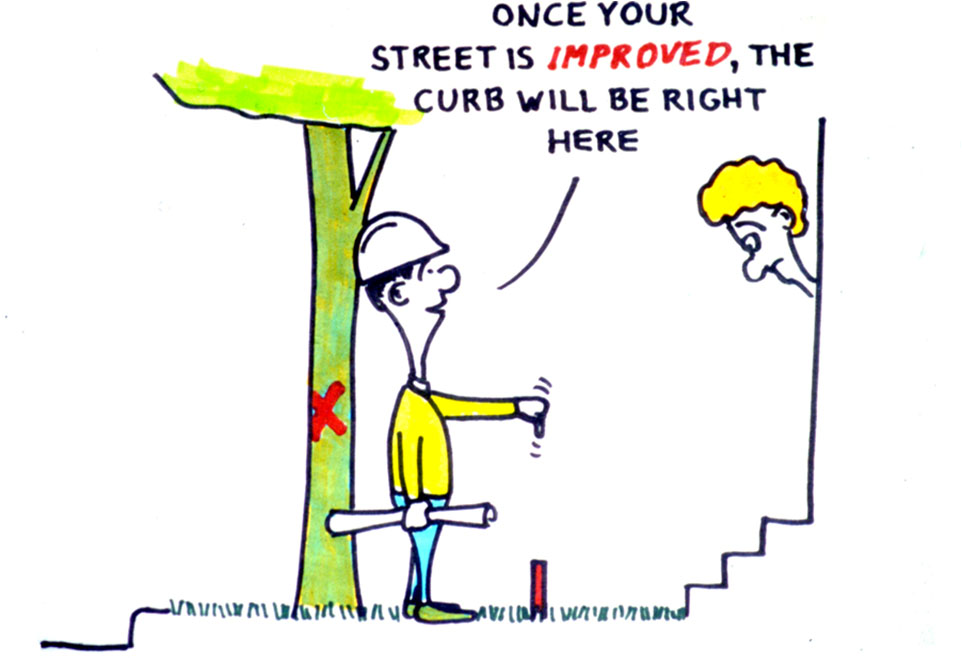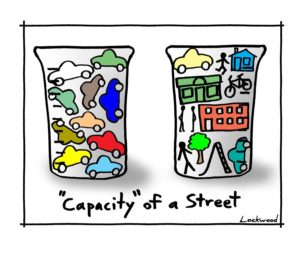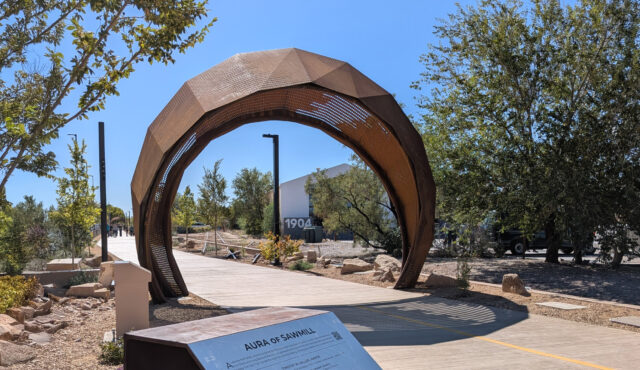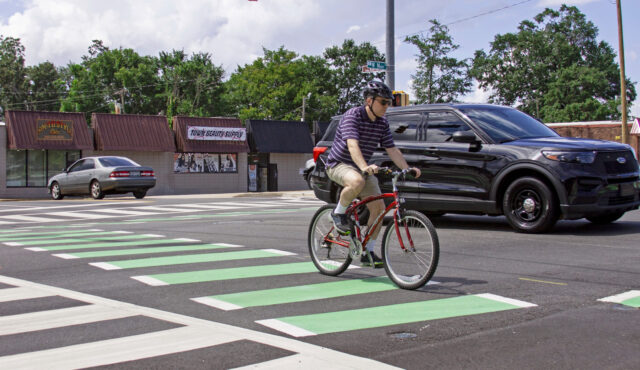Originally published in the January 2017 edition of the ITE Journal, a publication of the Institute of Transportation Engineers. It is reprinted here with permission. View the original here.

Samuel Beckett (1906–1989), the Irish novelist and playwright, wrote “Words are the clothes that thoughts wear.” Throughout history and in many fields, the use of language has influenced how ideas have been received by adorning thoughts with words that carry subjective meaning. Strategically assigning words to ideas can challenge or perpetuate biases, attitudes, and public opinion, and ultimately influence policies and culture.
Examples of language that contain and reinforce biases abound. In the 1970’s, common terms in workplaces included, “policeman, fireman, manpower, chairman, and man-hours.” The language was gender-biased and excluded women. Over time, societal values evolved to the point where the language was updated. Many people worked hard to reform the language to be gender-neutral, while opponents called the reform “being politically correct” and unnecessary. Today, gender-neutral language is common and accepted; examples include, “police officer, firefighter, human resources, chair, and person-hours.” This language reform supports gender equality, helping to change attitudes, policies, and culture. Gender-neutral language is not pro-woman; it is inclusive and objective.
The field of transportation engineering and planning has its own biased language. Much of the technical vocabulary regarding transportation and traffic engineering was developed between 1910 and 1965. The foreword of the Highway Capacity Manual, first published in 1965, states, “Knowledgeable professionals, acting in concert, have provided the value judgements needed to… and have established the common vocabulary…”1 Notice the acknowledgment of making “value judgments” and the purposeful development of a “common vocabulary.” The period prior to 1965 was the golden age of the automobile in the United States. Automobiles were equated to freedom, mobility, and success. Accommodating automobiles at high speeds became a major priority in society and, thus, a major priority for the transportation engineering profession. It is no coincidence that these values were built into the transportation vocabulary.
Many cities are now contending with the consequences of 50 years of automobile-oriented design. At the same time, values and expectations are evolving. Increasingly, people want high-performance transportation infrastructure that achieves a number of functions—accommodating people who walk, cycle, take transit, and drive cars for equity and economic reasons. There is a growing awareness that reducing automobile speeds increases safety and comfort, while contributing to community vitality and quality of life. At the same time, cities are using land previously dedicated to car parking lots for multiple other beneficial purposes. For a myriad of reasons, many wish to reduce vehicle-miles-traveled, the carbon footprints of automobiles in cities, the barrier-effects of in-city highways, and mobility inequity. Society’s relationship with the automobile has become more nuanced since the “common vocabulary” was developed half a century ago.
Similarly, the conventional performance metrics used by transportation professionals are evolving. Rather than focusing almost exclusively on motor vehicle metrics, contemporary transportation planning and design are increasingly considering factors such as safety, equity, and the mobility of diverse populations.
However, the continued use of biased language perpetuates these inherited biases, sounds discordant to people who do not share those biases, and can lead to unclear meaning.
Transportation professionals and the profession itself must be unbiased and avoid the appearance of bias. Reforming the language of our profession to make it more objective will allow us to communicate more clearly, make sound decisions, and serve the needs of a broad population. This paper has only one recommendation: that the Institute of Transportation Engineers (ITE) gather some knowledgeable professionals and act in concert to employ contemporary value judgements, update our language to be objective, and popularize objective terminology.
Below are some examples of biased or euphemistic transportation words, terms, and usage in bold letters, which are common today. Objective replacements are suggested in italics. In some cases, a different way of using the word or term is suggested. Some of the biases are obvious and some are subtle.
Efficiency is generally a good thing because using less land, energy, or other resources to achieve the same end is usually positive. Over the past 50 years, widening highways in metro areas, in an attempt to speed up motorists, has led to sprawl, car-dependency, and more vehicle miles traveled, and it hasn’t solved congestion. Yet it is common to hear, “We need to widen the highway to increase efficiency.” Per capita gasoline consumption in the United States is the highest in the world at 1.16 gallons (4.39 liters) per day. By comparison, the 2nd and 3rd highest countries were Canada and Kuwait using 3.62 and 2.28 liters per day per capita, respectively. Germany, 32nd; United Kingdom, 35th; and France, 63rd; used 0.84, 0.80, and 0.44 liters/day per capita, respectively.2 More “efficient” is often a euphemism for faster. An objective translation would be “Let us widen the highway so motorists can drive faster.

Improvement and improved are widely misused. Improvement implies making a situation better. Who can argue against an improvement? Commonly, when improvements are associated with intersections or streets, the professionals are referring to adding through lanes, turn lanes, channelization, or other means of increasing automobile throughput or speeds. However, more often than not, these changes make the situation worse from other perspectives. For example, pedestrians are required to cross a wider intersection when lanes are added. Using improvement in these circumstances indicates a bias toward motorists and against others. More recently, improvement has been used to describe narrowing and removing lanes to provide space for separated facilities for cyclists, wider sidewalks, etc. Still, there may be people who feel worse off as a result of the changes. Either way, an objective substitute should be used instead, such as modification, project, or change.
Enhancement or enhanced shows a bias in a similar way to improvement. For example, “The motor vehicle speeds were enhanced.” Either increased or decreased would be a better choice. Enhanced connotes that the situation has become better, which is a matter of opinion and perspective.
“The replacement of the highway, through the downtown, with a connected network of streets will increase the delay to motorists.” Obviously, delay is a negative word; nobody likes the idea of being delayed. It connotes that there is an unwanted or problematic increase in travel time that, ideally, should be remedied. However, for a professional to call the increase in travel time a delay shows a bias. Delay implies that motorists have a right to high speeds through the downtown and that society needs to set aside other considerations to provide motorists with high speeds. To many people, replacing the highway with a street network is a correction, and the changes to the travel times are just part of the correction. They feel the highway and the high speeds in the downtown were the result of outdated, automobile-oriented values, and bad public policy. To others, the slower speeds for motorists will increase safety, comfort, and access. To others, the streets would be easier to use on foot or by bicycle. So, some motorists may feel that the change in travel time is a delay, but an objective person should not take sides and, instead, use the objective measure of travel time. The audience may determine for themselves the advantages and disadvantages of the change.

“The reduction in the number of lanes to widen the sidewalks and plant street trees will result in a level of service that is unacceptable.” Desirable/Undesirable and acceptable/unacceptable can be misleading because the implication is that the change in the level of service for motorists is unacceptable from all perspectives, including the professional’s perspective who is making the statement. However, the pedestrians, shop owners, and arborists may feel the changes are acceptable or even desirable. Therefore, when these qualifiers are used, it should be required to indicate from whose perspective the conclusions are drawn: “The reduction… will result in a level of service for motorists that is unacceptable to motorists.”
Due to the biased nature of the common transportation vocabulary in favor of the automobile and high speeds, automobile-oriented outcomes have an advantage. This makes the profession appear biased. In order to remain unbiased and appear unbiased, the transportation profession ought to update its language and popularize objective words. A glossary of several biased words and phrases and suggestions for objective substitutes is provided in Table 1. There are many other biased words that are not included due to space limitations. Over time, the objective language will become normal and the transportation profession will be better aligned with contemporary values and better able to deliver services objectively to society.
References:
- Highway Capacity Manual. Washington, D.C.: Transportation Research Board, 1965.
- “Gasoline Consumption Per Capita Around the World.” Global Petrol Prices. www.globalpetrolprices.com/articles/52/. August 4, 2016. Accessed December 2, 2016.



